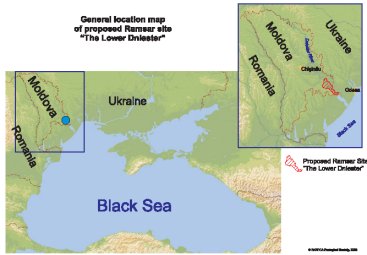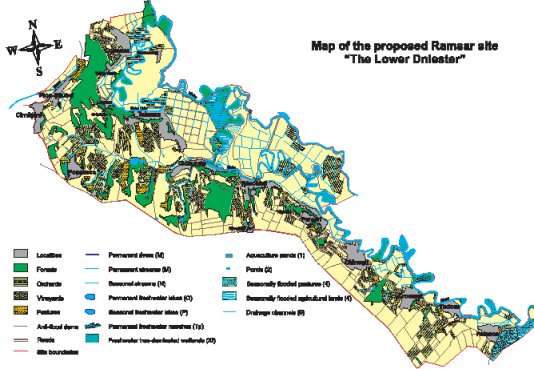Republic of Moldova designates lower reaches of the Dniester

The Bureau of the Convention on Wetlands is very pleased to announce that the Republic of Moldova, which joined the Convention in 2000, has designated its second Wetland of International Importance, effective 20 August 2003. Lower Dniester (Nistru de Jos) lies on both sides of the Dniester in Tighina and Slodozia districts and covers a surface area of 60,000 hectares. As Ramsar's Estelle Gironnet makes clear in her description of the site, based on the extraordinarily well-made Ramsar Information Sheets, the riverine habitats support a number of endangered and threatened bird and fish species and have an exceptional archaeological importance as well. Moreover, they help to complete the Ramsar status of the transboundary Dniester Delta, with two existing Ramsar sites in Ukraine.
 Lower Dniester (Nistru de Jos). 20/08/03; Tighina, Slodozia; 60,000 ha; 46 34'N 29 49'E; Nature Reserves; Landscape Reserve; Nature Monuments (paleontological). The designation of this part of the Dniester River in southeastern Moldova helps to complete the conservation of transboundary wetland the Dniester delta, with two Ramsar sites downstream in Ukraine. This complex of relict and transformed habitats of the River Dniester floodplain includes meandering zones with almost closed river loops typical for the northwest of the Black Sea basin, lakes and oxbows formed by river roaming, specific ash communities and unique old stand floodland poplar forest, Fraxineto-Populeta (albae). The site supports many globally endangered and vulnerable bird species among which 2 are nesting (Crex crex, Phalacrocorax pygmaeus), 4 are present on migration (Branta ruficollis, Aythya nyroca, Circus macrourus, Haliaeetus albicilla), 1 regular visitor (Pelicanus crispus), and fish such as the Danube Salmon (Hucho hucho), the European Mud-minnow (Umbra krameri) and various species of sturgeons.
Lower Dniester (Nistru de Jos). 20/08/03; Tighina, Slodozia; 60,000 ha; 46 34'N 29 49'E; Nature Reserves; Landscape Reserve; Nature Monuments (paleontological). The designation of this part of the Dniester River in southeastern Moldova helps to complete the conservation of transboundary wetland the Dniester delta, with two Ramsar sites downstream in Ukraine. This complex of relict and transformed habitats of the River Dniester floodplain includes meandering zones with almost closed river loops typical for the northwest of the Black Sea basin, lakes and oxbows formed by river roaming, specific ash communities and unique old stand floodland poplar forest, Fraxineto-Populeta (albae). The site supports many globally endangered and vulnerable bird species among which 2 are nesting (Crex crex, Phalacrocorax pygmaeus), 4 are present on migration (Branta ruficollis, Aythya nyroca, Circus macrourus, Haliaeetus albicilla), 1 regular visitor (Pelicanus crispus), and fish such as the Danube Salmon (Hucho hucho), the European Mud-minnow (Umbra krameri) and various species of sturgeons.
The wetland is an important site for freshwater migratory fish as it supports more than 90% of the species of the region and offers a high diversity of biotopes: riverbed spawning ground, areas of pelagic spawning and nursery. However, the construction of dams in the Dniester valley has affected the terrestrial, aquatic and intermediate ecosystems and large areas of important meadow spawning grounds were lost. Grazing is also considered as an important disturbance.
The site has recognized paleontological and archaeological value since the discovery of fossils and places such as tumuli, Cimmerian, Ghetic, Sarmatic and Slavic memorials. The RIS and the management plans of this site were prepared in 2001 during a Ramsar Small Grant Funds project. The creation of a Lower Dniester National Park is under discussion.
